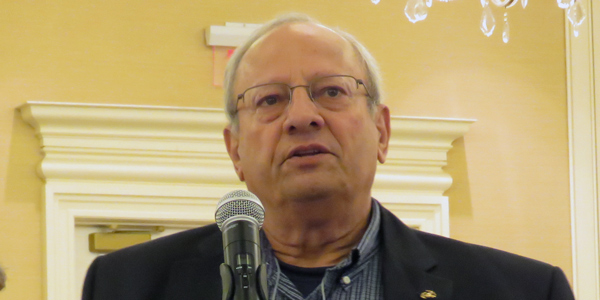By Rich Heidorn Jr.
WILMINGTON, Del. — The first time John Farber tried to retire, after 35 years in regulatory affairs at Florida Power & Light, didn’t work out so well.
It was 2007, and the collapse of the overheated housing market set off the financial crisis that would cut the value of the S&P 500 by half.
His retirement funds pummeled, Farber began looking anew for work. He found a job in October 2008 at the Delaware Public Service Commission as a public utility analyst.
Last week, after nine years at the PSC and regular attendance at PJM stakeholder meetings, he retired again. He hopes it’s for good this time, although he warns friends: You might want to shift your stock holdings to something more secure, just in case.
Before taking the PSC job, he had a question for his future boss, Bruce Burcat, then the commission’s executive director. Having lived his entire life in South Florida, he had never experienced the seasons. How harsh, he asked Burcat, are the winters in Delaware?
Don’t worry about it, Burcat, now executive director of the Mid-Atlantic Renewable Energy Coalition (MAREC), told him. “Maybe an inch or two [of snow] once or twice” a year.
With that assurance, Farber moved north to take the job. “That was a year when they had two 18-inch snowfalls,” Farber recalled. “I remember getting out there and just cursing Bruce Burcat up and down: ‘He lied to me! He absolutely lied to me.’”
But most winters weren’t that bad, Farber said, and he found himself surprised at being able to appreciate the seasons.
He also said he “appreciated the stakeholder community enduring me” despite his limited technical knowledge.
“I wish I was an engineer, an economist and a lawyer, but I’m none of those,” said Farber, who has an undergraduate business degree.
At his final Markets and Reliability Committee meeting Thursday, members celebrated his retirement with a standing ovation and a PJM coffee mug. Despite the gifts, he couldn’t let one last chance go by to press PJM officials on behalf of his Delaware ratepayers, attempting to pin down Vice President of Planning Steve Herling on potential costs for upgrading the Ohio Valley Electric Corp.’s transmission system. (See related story, Unanswered Questions Force Special Session on OVEC Integration.)
In an interview after the meeting, Farber was asked about the most important issue that had come up during his tenure representing Delaware before PJM.
“I’d guess I’d have to say it was Artificial Island,” he said, without hesitation. “That was a true Sisyphus moment. We’re still pushing that boulder up the mountain. Hopefully we can push it across the top.”
In 2016, FERC approved a cost allocation that would assign Delmarva Power & Light ratepayers 93% of the cost of the $280 million project, with all other transmission zones paying less than 1% each. The commission later agreed to consider rehearing requests over whether PJM’s use of the solution-based distribution factor (DFAX) cost allocation method is appropriate (EL15-95, ER15-2563). In April, PJM asked transmission owners to develop a more equitable allocation. (See Board Restarts Artificial Island Tx Project; Seeks Cost Allocation Fix.)
Having turned 70 in August, Farber said “it just seemed like this was the time” to retire. “I think we’ve done as much on Artificial Island as we can. Now we’re waiting to see what FERC does,” he said.
“A lot of what goes on at PJM is not as singularly significant as was Artificial Island,” he continued, cautioning that he was speaking for himself and not the PSC. “I don’t know that the ‘death of a thousand cuts’ is appropriate, but it’s a thousand different things that are going to be happening that are flowing through PJM, through FERC and down ultimately to the rates that Delaware customers have to pay.”
He mentioned capacity and energy costs and a rising concern: supplemental transmission projects that are not subject to strict PJM review. (See Report Decries Rising PJM Tx Costs; Seeks Project Transparency.)
And as he leaves, a new worry: The U.S. Department of Energy’s proposal to give cost-of-service treatment to coal and nuclear plants in PJM. “It’s not like putting a thumb on the scale,” he said of the proposal by Energy Secretary Rick Perry. “It’s like jumping on the scale with both feet.”
As the MRC members filtered out of the conference room, Mike Borgatti of Gabel Associates stopped by to wish Farber well.
“It’s been a pleasure working with you all these years,” said Borgatti, a former legal analyst for the New Jersey Board of Public Utilities who now represents mostly generators before PJM.
“It’s been great working with you,” Farber responded, deadpan, “even though you did go to the dark side.”
“I’ve got some DR [demand response] clients too, John,” Borgatti protested, with mock defensiveness.
“Where are you headed?” Borgatti asked next.
“I haven’t had time to plan,” Farber responded. “All I know is if it’s snowing up here, I’m going to head south.”
By Saturday, his first day of retirement, he had already updated his LinkedIn page. His new “office”: Sunset Grill, Cocoa Beach, Fla.





